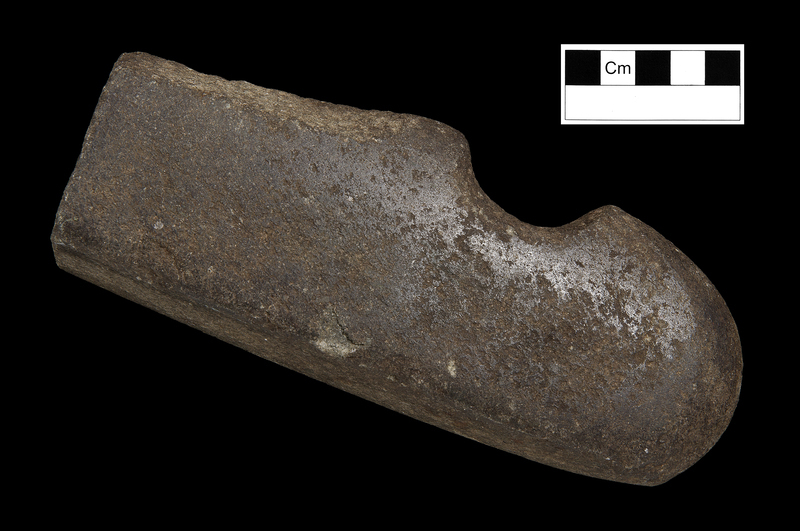?Wedge Item Number: 1924.33.2 from the Pitt Rivers Museum

Description
Stone tool with one rounded end, a groove on one side and the other end broken at a 90 degree angle. [CAK 17/05/2010]
Longer Description
Stone tool with one rounded end, a groove on one side and the other end broken at a 90 degree angle. [CAK 17/05/2010]
Primary Documentation
Accession book entry - C. HARRISON, Esq. Specimens collected from the HAIDA of QUEEN CHARLOTTE ID., B.C.... - Butt of stone adze-head with single hafting-notch
No additional information on catalogue cards. [JC 5 9 1996]
Written on object - HAIDA QU. CHARLOTTE ID Pres by C. Harrison 1924 [CAK 29/05/2009]
Related Documents File - The Haida Project Related Documents File contains video of research sessions and interviews with Haida delegates from September 2009 as part of the project ‘Haida Material Culture in British Museums: Generating New Forms of Knowledge'. It also includes post-visit communications that discuss object provenance. For extensive photographic, video, and textual records documenting the Haida research visit as a whole, including but not limited to preparations of objects for handling, travel logistics, British Museum participation, transcribed notes from research sessions and associated public events held at PRM, see the Haida Project Digital Archive, stored with the Accessions Registers. Original hand-written notes taken during research sessions have been accessioned into the Manuscripts collection, in addition to select other materials. [CAK 02/06/2010]
Research Notes
The following information comes from Haida delegates who worked with the museum's collection in September 2009 as part of the project “Haida Material Culture in British Museums: Generating New Forms of Knowledge”:
This tool was viewed alongside other stone tools on Monday Sept 14, 2009. Christian White identified this is a wedge, missing the tip. He also characterised it as a splitting axe. He thought it would have been lashed to a handle. He suggested that this tool, as well as 1924.33.1 and 1924.33.4 could be used to shape a canoe. Another delegate thought the tool would have been held by clamping one's hand over the groove in the topside of the tool, with the groove positioned between the thumb and first-finger. The user would place their other hand, clenched into a fist with the knuckles (to the topside of the lower fingers), placed underneath the tool to provide support. Jaalen Edenshaw identified this tool as a hammer. See also 1924.33.1.
In response to the collection of stone tools, delegates commented that the manufacture of stone tools occurred on Haida Gwaii and that it is possible to identify places where tools were made today based on archaeological analysis of detritus at the sites. They noted that there are a variety of stone types on Haida Gwaii and most of the tools found on Haida Gwaii were produced locally. There are sources of obsidian, for instance, although basalt is more common. [CAK 17/05/2010]
Item History
- Made in British Columbia Haida Gwaii NW Coast, Canada
- Collected by Charles Harrison
- Received from Charles Harrison during 1924
What
Who
- Culture
- Haida
- Field Collector
- Charles Harrison
- Received from
- Charles Harrison
Where
- Holding Institution
- Pitt Rivers Museum
- Made in
- British Columbia Haida Gwaii NW Coast, Canada
When
- Acquisition Date
- during 1924
Other
- Keyword
- ?Wedge; ?Axe; ?Hammer; ?Adze
- Class
- Tool